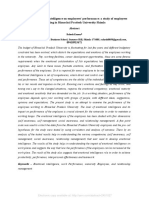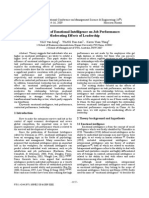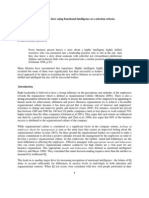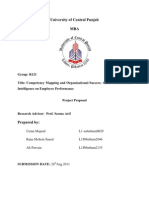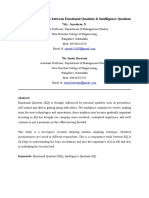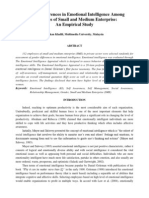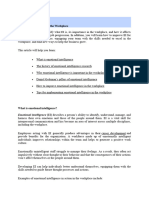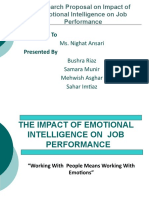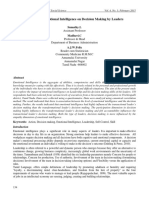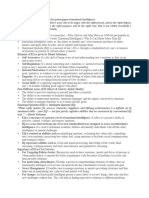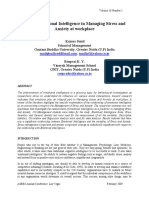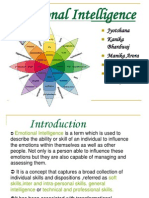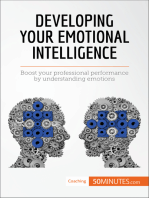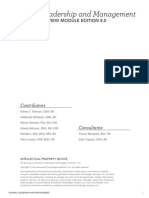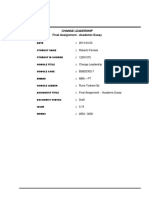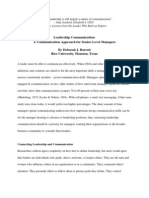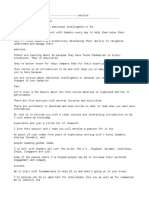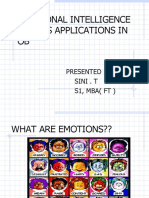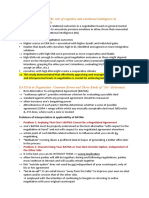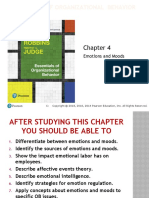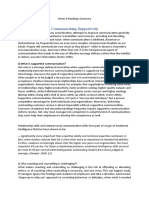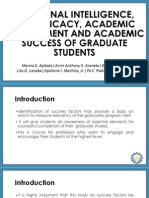Ei and Work Performance
Ei and Work Performance
Uploaded by
Elena GhizdăreanuCopyright:
Available Formats
Ei and Work Performance
Ei and Work Performance
Uploaded by
Elena GhizdăreanuOriginal Description:
Copyright
Available Formats
Share this document
Did you find this document useful?
Is this content inappropriate?
Copyright:
Available Formats
Ei and Work Performance
Ei and Work Performance
Uploaded by
Elena GhizdăreanuCopyright:
Available Formats
Europes Journal of Psychology 1/2009
www.ejop.org
Emotional Intelligence and Work Performance among Executives
Dr.C.P. Khokhar
Professor, Department of Psychology,
Gurukul Kangri University, Haridwar
Tulika Kush
Research Scholar, Department of Psychology,
Gurukul Kangri University, Haridwar
Abstract
Preset study explains the performance of executives on different levels of emotional
intelligence and provides a link between emotional intelligence and effective work
performance. 20 Male executives (out of 200) within the age range of 40 to 55yrs. from
BHEL (Haridwar) and THDC (Rishikesh) of Uttarakhand State (India) were selected.
Emotional intelligence scale constructed by Dhar, Hyde and Pethe (2001) constructed
and standardized on the Indian Population and work Performance rating scale
constructed by Prof A. P. Singh and Prof D. M. Pestonje (for the Indian population) were
used to measure emotional intelligence and work performance of executives. T-tests for
independent groups were used to measure the mean difference between groups. The
findings of the study revealed that executives having higher emotional intelligence show
better quality of work performance as compared to their counterparts.
Key Words - Emotional intelligence, Work performance.
Emotional intelligence is the capacity of an individual to define his own emotions
and to become sensitive to those that he perceives from the environment and the
circle of people he is interacting with. It may also be that emotional intelligence is
the use of knowledge of these emotions to control situations and create plans and
decisions based on the perceived emotions. Resources would further add that
emotional intelligence is part of our personality that dictates us to become more
aware of what triggered a specific reaction, both done by the self and people
surrounding the "self". Emotional Intelligence (EI), often measured as an Emotional
Europes Journal of Psychology
Intelligence Quotient (EQ), describes an ability, capacity, or skill to perceive, assess,
and manage the emotions of one's self, of others, and of groups. As a relatively new
area of psychological research, the definition of EI is constantly changing.
Goleman (1998, p. 317) defines EI as the capacity for recognizing our own feelings
and those of others, for motivating ourselves, and for managing emotions well in
ourselves and in our relationships. Martinez (1997, p. 72) refers to emotional
intelligence as being: an array of non-cognitive skills, capabilities and competencies
that influence a persons ability to cope with environmental demands and pressures
(cited in Dulewicz and Higgs, 2000, p. 342).
Mayer and Cobb, 2000 explain that Emotional intelligence consists of these "four
branches of mental ability" that is Emotional identification, perception and
expression, Emotional facilitation of thought, Emotional understanding and Emotional
management.
The high EI individual, relative to others, is less apt to engage in problem behaviors,
and avoids self-destructive, negative behaviors. The high EI person is more likely to
have possessions of sentimental attachment around the home and to have more
positive social interactions, particularly if the individual scored highly on emotional
management. Such individuals may also be more adept at describing motivational
goals, aims, and missions. (Mayer, Salovey, & Caruso, 2004, p. 210).
Emotional Intelligence is increasingly relevant to organizational development and
developing people, because the EQ principles provide a new way to understand
and assess people's behaviors, management styles, attitudes, interpersonal skills, and
potential. Emotional Intelligence is an important consideration in human resources
planning, job profiling, recruitment interviewing and selection, management
development, customer relations and customer service, and more.
Golemans has given an emotional competence framework model. Where
emotional Competence is a learned capability based on emotional intelligence that
results in outstanding performance at work. It leads to and based on emotional
intelligence, a certain level of emotional intelligence is necessary to learn emotional
competencies. For predicting the performance these competencies were needed
to identify and measure. Emotional Intelligence by itself is probably not a strong
predictor of job performance instead it provides a foundation for emotional
competencies which are strong predictor of job performance.
Emotional Intelligence and Work Performance
Our emotional intelligence determines our potential for learning the practical skills
viz. personal skills and social skills. These skills lead to superior performance in field of
work which based on the five elements: self-awareness, motivation, self-regulation,
empathy, and adeptness in relationships. Our emotional competence shows how
much of that potential we have translated into on-the-job capabilities."
Emotional intelligence may contribute to work performance (as reflected in salary,
salary increase, and company rank) by enabling people to nurture positive
relationships at work, work effectively in teams, and build social capital. Work
performance often depends on the support, advice, and other resources provided
by others (Seibert, Kraimer & Liden, 2001). Emotional intelligence may also contribute
to work performance by enabling people to regulate their emotions so as to cope
effectively with stress, perform well under pressure, and adjust to organizational
change.
Interpersonal
facilitation
pertains
to
interpersonally
oriented
behaviors
that
contribute to organizational goal accomplishment (Van Scotter & Motowidlo, 1996,
p. 526). Emotional intelligence may contribute to the quality of peoples relationships
at work because emotions serve communicative and social functions, conveying
information about thoughts and intentions, and helping to coordinate social
encounters (Keltner & Haidt, 2001). Emotion-related abilities should help people
choose the best course of action when navigating social encounters. For example,
the ability to decode facial expressions of emotion can help one to evaluate how
other people respond to ones words and actions, yielding important information for
adjusting ones behavior (Nowicki & Duke, 2001). The ability to use emotions to guide
thinking can help one to consider both emotions and technical information when
evaluating an interpersonal problem. The ability to manage emotions should help
individuals experience and express emotions that contribute to favorable social
encounters, in part through emotional contagion (Hatfield, Cacioppo, & Rapson,
1994).
Despite important exceptions (Parrott, 1993), people are usually motivated to seek
pleasant feelings and avoid unpleasant emotions. The ability to manage emotions
can help people nurture positive affect, avoid being overwhelmed by negative
affect, and cope with stress (Mayer & Salovey, 1997). Other emotional abilities, such
as perceiving and understanding emotions, also contribute indirectly to the quality
of emotional experience by helping people to identify and interpret cues that inform
self-regulatory action. Therefore emotional intelligence should contribute to positive
affect and attitudes at work.
Europes Journal of Psychology
A very recent and excellent review of the EI literature (Dulewicz and Higgs, 2000)
demonstrates clearly that EI impacts on work success. Work success was defined in
this review as advancement in ones work organization.
Methods
Sample A sample200 Male executives within the age range of 40 to 55yrs, having
graduation degree in engineering and masters degree in management, were
selected from BHEL (Haridwar) and THDC (Rishikesh) of Uttarakhand State (India) on
random basis out of which 20 executives ( 10 with High EI and 10 with Low EI
executives) were selected. Mean and SD of the present study sample were
141.87and 12.26 respectively. One unit of SD above and below the Mean value set
to categorized the executives high and low in EI that were154.12 and
129.61respectively.
Tools
Emotional intelligence scale constructed by Dhar, Hyde and Pethe (2001) is in Hindi
language based on 10 factors having 34 items with reliability of .88 and validity .93
standardized on Indian population. It is used to measure the level of emotional
intelligence. The items of the scale are directly related to the concept of emotional
intelligence. It includes self-awareness, empathy, self motivation, emotional stability,
managing relations, integrity, self-development, value-orientation, commitment and
altruistic behavior.
Performance rating scale was constructed and standardized for Indian population
by A. P. Singh and D. M. Pestonjee. Scale consists of 14 items to be responded at five
point rating scale. Reliability of the scale is .99 and the validity of the scale is .84
(N=200).
Results
Present study reveals that the level of emotional intelligence in executives relates
with work performance.
Emotional Intelligence and Work Performance
Mean and SD of high and low emotionally intelligent groups of
TABLE-1
executives on different dimensions of work performance.
S.NO.
1.
Dimensions of work
Groups of
performance
Exicutives
Quality
of
3.
4.
5.
6.
8.
9.
10.
11.
12.
13.
14.
SD
10
4.6
.5164
Low EI
10
3.9
.5677
effort High EI
10
4.5
.5271
expended on job.
Low EI
10
3.8
.6325
Speed on the job.
High EI
10
4.6
.5164
Low EI
10
3.8
.4217
High EI
10
4.5
.5271
Low EI
10
3.7
.4831
High EI
10
4.6
.5164
Low EI
10
3.9
.3162
handling High EI
10
4.6
.5164
Low EI
10
3.8
.7888
Ability to work without High EI
10
4.7
.4831
supervision.
Low EI
10
3.7
.6750
Ability to handle different High EI
10
4.8
.4216
jobs.
Low EI
10
3.8
.6325
Dependability.
High EI
10
4.4
.8433
Low EI
10
3.8
.7888
Ability to get along with High EI
10
4.6
.5164
others.
Low EI
10
3.9
.5677
and High EI
10
4.8
.4216
punctuality
Low EI
10
4.2
.6325
Planning Ability.
High EI
10
4.7
.4831
Low EI
10
3.9
.7379
High EI
10
4.7
.4831
Low EI
10
3.8
.6325
work High EI
10
4.9
.3162
Low EI
10
3.8
.4216
Amount
of
Quantity of work.
Capacity of work.
Care
in
company.
7.
Mean
work High EI
performance
2.
Attendance
Initiative on the job.
Overall
performance.
t
2.884**
2.689*
3.795**
3.538**
3.656**
2.683*
3.810**
4.160**
1.643
2.884**
2.496*
2.868*
3.576**
6.601**
*P > .05
**P > .01
Difference between the mean scores of high and low emotionally intelligence
executive groups on all the dimensions of work performance is in favor of high
Europes Journal of Psychology
emotionally intelligence group of executive except for one dimension that is
dependability.
The t values are significant at .01 level for Quality of work performance, Speed on
the job, Quantity of work, Capacity of work, Ability to work without supervision, Ability
to handle different jobs, Ability to get along with others, Initiative on the job and
Overall work performance dimensions of work performance. t value of Amount of
effort expended on job, Care in handling company, Attendance and punctuality,
Planning Ability dimensions of work performance are significant at .05 level.
Discussion
Emotional Intelligence can be beneficial in many areas of life; it calls for the
acquisition of certain emotional skills. However, the application of its usefulness has
been most frequently documented in the professional workplace. Organizations not
only deal with material but also deal with peoples. The trust and credibility of a
manager and the organization he or she is working will reflects its emotional
intelligence level. Todays workplace emphasizes on better teamwork, flexibility and
services.
Emotional intelligence uniquely explained individual work performance (simulated)
over and beyond the level attributable to general intelligence (IQ) (Thi Lam & Kirby,
2002). Feist and Barron, 1996 concluded that emotional and social competencies
were four times more important than IQ in determining professional success and
prestige.
Based on the statistical analysis, the observations and inferences drawn are in favor
of highly emotionally intelligent executives as their emotional competency is also
high which consists of self-awareness, self-regulation, motivation, empathy and social
skills, considered as the strong predictors of work performance.
Emotional competency gives them a realistic confidence to perceive challenges. As
a result of this, they constantly grow and improve their quality, quantity, speed and
the capacity of work, which can be illustrated from our results. Also it is found that
the executives having high emotional intelligence show better quality, speed in
work, more capacity of doing work as compared to their counter parts who are
having low emotional intelligence. Study conducted by Goleman (1998) and Mayer,
Selovey and Caruso (1998) also supports this result. They emphasize that emotional
intelligence by itself is probably not a strong predictor of job performance, instead it
Emotional Intelligence and Work Performance
provides foundation for emotional competencies which are strong predictor of job
performance. They are more creative and practical towards emotional prompts
elicited from the inner self and the immediate environment and try to manipulate
the ongoing environment to their advantage by reacting appropriately which
enhances their ability to handle different jobs, they take much care in handling
company, and also have a better planning ability.
As they have developed an accurate and better vision for their task they are less
dependable and are able to work properly even without supervision. This finding is
supported by Stein, S. (2002) in a review article discussed about the EQ factor: The
sample group scored slightly higher than average on total EQ. In order from most to
least above the norms, the group scored above average on independence,
assertiveness, optimism, self-actualization, and self-regard.
Emotional Maturity and Emotional Sensitivity is reflected in the behavioral pattern
exhibited by the executives while dealing with the inner self and the immediate
environment. Highly emotional intelligent executives have the ability to recognize
different feeling. They have an adequate understanding of their own and others
emotional make up to move people in the direction of accomplishing the goals. A
cheerful executive communicates a message of confidence and self-respect. Its the
ability to share and accept another persons feelings which help in having a good
inter personal relations and the ability to get along with others. Research has shown
that the primary cause of failures among executives was their poor inter-personal
relations at the workplace. In a research done by Snarey and Vaillant, (1985) it is found
that in determining the success IQ had little relation to workplace and personal
success. More important was the ability to handle frustration, control emotions and get
along with others. Research done by (Pool and Cotton, 2004) also support our results
according to him possessing high level of EI permits individuals have a closer
understanding of people and their surroundings.
Highly emotionally intelligent executives are more punctual and take maximum
initiatives on the job, they put much amount of efforts to expend their job and have
better work performance as compared to their counterparts. Results also favor the
same and this finding was also supported by Len Tischler et al (2002) he examined
the linking emotional intelligence, spirituality and work place performance and
displayed a positive relationship between emotional intelligence and work place
success and also by (Cooper and Sawaf, 1997; Gates, 1995; Megerian and Sosik,
1996; Wright and Staw, 1999) according to them Emotional intelligence has also
evoked a keen interest among practitioners because of its wide applicability to a
host of work place issues including job satisfaction, absenteeism, organizational
7
Europes Journal of Psychology
commitment, organizational citizenship Emotional intelligence has been identified as
one of the important behavioral constructs considered to be a major contributor to
performance (Goleman, 1995; Goleman, 1998; Hay Group, 2003).
Executives, in particular, need high EQ because they represent the organization to
the public, they interact with the highest number of people within and outside the
organization and they set the tone for employee morale, says Goleman. The success
of an individual working within an organization is a function of emotional
intelligence. Much of this success depends on the abilities of individuals to motivate
them and to accomplish tasks by forming teams from a loose network of fellow
workers with specific talents and expertise. Leaders with empathy are able to
understand their employees needs and provide them with constructive feedback.
It is clear that those organizations that are successful in todays dynamic business
world take a more proactive approach to developing a positive service climate. It
follows that excellent service, with positive emotional content, is most likely to be
facilitated by employees who are emotionally self aware and who understand
others on a more emotional level. Positive reinforcement of an emotionally intelligent
environment will enable the development of a service oriented climate which is
authentic in nature, and therefore more effective.
References
Cooper R. & Sawaf A. (1997). Executive EQ: Emotional Intelligence in Business. London,
Orion.
Dulewicz, Higgs, M (2000), Emotional Intelligence, A Review and Evaluation Study, Henley
Management College, Henley-on-Thames.
'Emotional Development and Emotional Intelligence,' by Peter Salovey, PhD, and John
Mayer, PhD (Basic Books, 1997).
'Executive EQ: Emotional Intelligence in Leadership and Organization,' by Robert Cooper
and Ayman Sawaf (Perigree, 1998).
Emotional Intelligence at Work,' by Hendrie Weisinger, PhD (Jossey-Bass, 1997).
Emotional Intelligence and Work Performance
Feist, G. J., & Barron, F. (1996, June). Emotional intelligence and academic intelligence in
career and life success. Paper presented at the Annual Convention of the American
Psychological Society, San Francisco, CA.
Fleishman, E., & Harris, E. F. (1962). Patterns of leadership behavior related to employee
grievances and turnover. Personnel Psychology, 15, 43-56.
Gowing, M. (in press). Measurement of individual emotional competence. In C. Cherniss
& D. Goleman (Eds.), Emotional competence in organizations .
Goleman, D. (1995). Emotional intelligence. New York: Bantam.
Goleman, D. (1996). Emotional Intelligence: why it can matter more than IQ
Goleman, D. (1998). Working with emotional intelligence. New York: Bantam.
Goleman, D (1996), Emotional Intelligence: Why It Can Matter More Than IQ, Bloomsbury
Publishing, London.
Goleman, D (1998), Working with the Emotional Intelligence, Bantam Books, New York,
NY.
Hatfield, E., Cacioppo, J.T., & Rapson, R.L. (1994). Emotional contagion. New York:
Cambridge University Press.
Keltner, D. & Haidt, J. (2001). Social functions of emotions. In T.J. Mayne and G.A.
Bonanno (eds.): Emotions: Current issues and future directions (pp. 192-213). New York:
Guilford.
Len Tischler, Jerry Biberman, & Robert Mckeage (2002). Linking Emotional intelligence,
spirituality and workplace performance: Definitions, models and ideas of research.
Journal of Managerial Psychology, 17, 203-218
Martinez, M.N (1997), "The smarts that count", HR Magazine, Vol. 42 No.11, pp.72-8.
Mayer, J. D., Caruso, D., & Salovey, P. (1998a). The multifactor emotional intelligence
scale . Unpublished report available from the authors.
Mayer, J. D., Salovey, P., & Caruso, D. (1998b). Competing models of emotional
intelligence. In R. J. Sternberg (Ed.), Handbook of human intelligence (2nd ed., ). New
York: Cambridge University Press.
Europes Journal of Psychology
Mayer, J. D., Salovey, P., & Caruso, D. R. (2000). Models of emotional intelligence. In R. J.
Sternberg (Ed.). Handbook of Intelligence (pp. 396-420). Cambridge, England:
Cambridge University Press.
Mayer, J., Salovey, P., Caruso, D.R., and Sitarenios, G. (2001) "Emotional intelligence as a
standard intelligence." Emotion, 1, 232-242.
Mayer, J.D. & Salovey, P. (1993). The intelligence of emotional intelligence. Intelligence,
17, 433-442.
Mayer, J.D., Salovey, P., Caruso, D.R. (2004), "Emotional intelligence: theory, findings, and
implications", Psychological Inquiry, Vol. 15 No.3, pp.197-215.
Mayer, JD., & Cobb (2000), Educational policy on emotional intelligence: Does it make
sense? Educational Psychology Review, 12, 163-183.
Megerian, L.E., & Sosik, J.J (1996). An affair of the heart: Emotional intelligence and
transformational ledership. The journal of leadership studies, 3(3), 31-48.
Nowicki, S., Jr. & Duke, M.P. (2001). Nonverbal receptivity: The diagnostic analysis of
nonverbal accuracy (DANVA). In J.A. Hall & F.J. Bernieri (eds.): Interpersonal sensitivity:
Theory and measurement (pp. 183-198). Mahwah, NJ: Erlbaum.
Parrott, W.G. (1993). Beyond hedonism: Motives for inhibiting good moods and for
maintaining bad moods. In D.M. Wegner & J.W. Pennebaker (eds.): Handbook of mental
control. Englewood Cliffs, NJ: Prentice-Hall.
Pool, P. and Cotton, C. W. (2004). Emotional Intelligence: Improving the Odds of Leader
Success, 1-8.
Seibert, S.E., Kraimer, M.L., & Liden, R.C. (2001). A social capital theory of career success.
Academy of Management Journal, 44, 219-237.
Snarey, J. R., & Vaillant, G. E. (1985). How lower- and working-class youth become
middle-class adults: The association between ego defense mechanisms and upward
social mobility. Child Development, 56(4), 899-910.
Thilam, L., & Kirby, S. (2002). Is emotional intelligence advantage? The journal of social
Psychology, 142 (1), 133-145.
10
Emotional Intelligence and Work Performance
Van Scotter, J.R. & Motowidlo, S.J. (1996). Interpersonal facilitation and job dedication as
separate facets of contextual performance. Journal of Applied Psychology, 81, 525-531.
Wright, T.A. & Staw, B.M. (1999). Affect and favorable work outcomes: Two longitudinal
tests of the happy-productive worker thesis. Journal of Organizational Behavior, 20, 123.
About the authors:
C.P.Khokhar
Professor & Head department of Psychology
Gurkul Kangri University, Hardwar, India.
Presently engaged in teaching and research.
Published more than 30 research papers and supervised more 20 PhD students.
Completed research projects and written books. Area of specialization is Health
Psychology and parenting.
Email: dr.cpkhokhar@rediffmail.com
Miss Tulika Kush
Masters degree M.A Psychology from H.N.B. Garhwal University (2004-2006) India.
M. Phil Psychology from Barkatullah University, Bhopal during the year (2006-2007)
Completed two research projects titled Mental Imaginary of adolescence: Study of
birth order and gender (2005-2006) and Study of emotional Intelligence, SelfEfficacy Subjective Well-Being in organizational context (2006-2007).
Presently working on emotional intelligence and enrolled as a student of PhD in
psychology from Gurukul Kangri University, Haridwar.
Email: tulikakush@yahoo.co.in
11
Reproduced with permission of the copyright owner. Further reproduction prohibited without permission.
You might also like
- Emotional Intelligence Assignment 1 PDFDocument10 pagesEmotional Intelligence Assignment 1 PDFAbdelßasset Zkr100% (5)
- SSRN Id2451027Document13 pagesSSRN Id2451027purple girlNo ratings yet
- Chapter 5 - Findings, Suggestions and Conclusion - RevisedDocument17 pagesChapter 5 - Findings, Suggestions and Conclusion - RevisedAzra AhmedNo ratings yet
- The Effects of Emotional Intelligence in Employees PerformanceDocument16 pagesThe Effects of Emotional Intelligence in Employees PerformanceMohan SubramanianNo ratings yet
- RRL QuenieDocument8 pagesRRL QuenieJasper Mortos VillanuevaNo ratings yet
- Research ArticleDocument30 pagesResearch ArticleFatima NaqviNo ratings yet
- A Study On Emotional Intelligence Measures: Analysis and ComparisonDocument31 pagesA Study On Emotional Intelligence Measures: Analysis and ComparisonSiri DevarapalliNo ratings yet
- Paper On Emotional IntelligenceDocument15 pagesPaper On Emotional IntelligenceDhani Shanker Chaubey100% (1)
- Development of The Emotional Intelligence Scale PDFDocument13 pagesDevelopment of The Emotional Intelligence Scale PDFFrancisco MuñozNo ratings yet
- Influence of Emotional Intelligence andDocument4 pagesInfluence of Emotional Intelligence andKrisna Criselda SimbreNo ratings yet
- Emotional IntellegenceDocument14 pagesEmotional Intellegencegozde_erisNo ratings yet
- 05318156Document6 pages05318156Mohd Shafie Mt SaidNo ratings yet
- Review EI Measurement in IndonesiaDocument2 pagesReview EI Measurement in IndonesiaNabila HumaidaNo ratings yet
- Role of Emotional Intelligence in Ethical Decision MakingDocument3 pagesRole of Emotional Intelligence in Ethical Decision Makingsharpshooter0999No ratings yet
- Influence of Emotional Intelligence and Gender On Job Performance and Job Satisfaction Among Nigerian PolicemenDocument8 pagesInfluence of Emotional Intelligence and Gender On Job Performance and Job Satisfaction Among Nigerian PolicemenArif ullahNo ratings yet
- Emotional Intelligence As A Selection CriteriaDocument9 pagesEmotional Intelligence As A Selection CriteriaA Rathina SwamyNo ratings yet
- Ethics Presentation: Emotional IntelligenceDocument6 pagesEthics Presentation: Emotional IntelligenceaashishNo ratings yet
- Emotional IntelligenceDocument110 pagesEmotional IntelligenceVicNo ratings yet
- Uzma 'S Project ProposalDocument8 pagesUzma 'S Project ProposalDr-Ahmad Nawaz ZaheerNo ratings yet
- A Comparative Study Between Emotional Quotient and Intelligence QuotientDocument10 pagesA Comparative Study Between Emotional Quotient and Intelligence QuotientJayaJayashNo ratings yet
- 19 Ashkan Khalili PDFDocument10 pages19 Ashkan Khalili PDFAthirah Mustaffar KamarNo ratings yet
- Emotional Intelligence Scale Report ChanaDocument11 pagesEmotional Intelligence Scale Report ChanadwfdwqfNo ratings yet
- Introduction Section (Emotional Intelligence)Document5 pagesIntroduction Section (Emotional Intelligence)David Fluky FlukyNo ratings yet
- Role of Emotional Intelligence in Managing Stress Among Employees at WorkplaceDocument27 pagesRole of Emotional Intelligence in Managing Stress Among Employees at WorkplaceInternational Journal of Innovative Research and StudiesNo ratings yet
- Emotional Intelligence What Is Emotional Intelligence ?Document7 pagesEmotional Intelligence What Is Emotional Intelligence ?shanNo ratings yet
- The Role of Emotional Intelligence Towards Employee CommitmentDocument10 pagesThe Role of Emotional Intelligence Towards Employee CommitmentDennyNo ratings yet
- Sample Thesis Emotional IntelligenceDocument8 pagesSample Thesis Emotional Intelligencemelissamooreportland100% (2)
- An Empirical Study On Impact of The Emotional Intelligence Levels of Employees On Their Job Satisfaction in Cement IndustryDocument6 pagesAn Empirical Study On Impact of The Emotional Intelligence Levels of Employees On Their Job Satisfaction in Cement IndustryarcherselevatorsNo ratings yet
- 19 Ashkan KhaliliDocument10 pages19 Ashkan KhalilititoNo ratings yet
- Emotional IntelligenceDocument5 pagesEmotional Intelligenceayesha rajputNo ratings yet
- Emotional Intelligence Job SatisfacitionDocument6 pagesEmotional Intelligence Job Satisfacitionsasaenescu2579No ratings yet
- Kannaiah and Shanthi 2015Document9 pagesKannaiah and Shanthi 2015shammu mayrajNo ratings yet
- Study of Emotional Intelligence and Well-Being AmoDocument10 pagesStudy of Emotional Intelligence and Well-Being AmoMalik DaniyalNo ratings yet
- Emotional Intelligence and Its Impact On Employee Performance and Stress Level While Working From HomeDocument17 pagesEmotional Intelligence and Its Impact On Employee Performance and Stress Level While Working From HomeJaveriya FarheenNo ratings yet
- EJ1320243Document11 pagesEJ1320243Alya MaisarahNo ratings yet
- The Effect of Labor's Emotional Intelligence On Their Job SatisfactionDocument19 pagesThe Effect of Labor's Emotional Intelligence On Their Job SatisfactionRenny RetnowatieNo ratings yet
- All Learning Has An Emotional BaseDocument7 pagesAll Learning Has An Emotional BaseTahir Naeem JattNo ratings yet
- Implication of Emotional Intelligence On Organizational Performance: A Study of Social Development Secretariat, Abuja, NigeriaDocument8 pagesImplication of Emotional Intelligence On Organizational Performance: A Study of Social Development Secretariat, Abuja, NigeriaInternational Journal of Arts, Humanities and Social Studies (IJAHSS)No ratings yet
- Impact of Emotional Intelligence On Employees' PerformanceDocument24 pagesImpact of Emotional Intelligence On Employees' PerformanceManu Kaur100% (6)
- Ed 535684Document4 pagesEd 535684Ana Laura VelazquezNo ratings yet
- A Study On Emotional Intelligance at WiproDocument54 pagesA Study On Emotional Intelligance at WiproRajesh BathulaNo ratings yet
- Unit 5.2Document16 pagesUnit 5.2Priyanka SharmaNo ratings yet
- Content ServerDocument13 pagesContent ServerKameswara Rao PorankiNo ratings yet
- Effect of Emotional Intelligence On Academic AchievementDocument16 pagesEffect of Emotional Intelligence On Academic AchievementarjitNo ratings yet
- Arjit Ad Prsad EIDocument16 pagesArjit Ad Prsad EIarjitNo ratings yet
- Exploring The Link Between Emotional Intelligence & Workplace SpiritualityDocument10 pagesExploring The Link Between Emotional Intelligence & Workplace SpiritualityTJPRC PublicationsNo ratings yet
- Impact of EI On Job PerformanceDocument24 pagesImpact of EI On Job PerformanceBushraRiazNo ratings yet
- Emotional Intelegence (EQ)Document2 pagesEmotional Intelegence (EQ)jack sparowNo ratings yet
- Influence of Emotional Intelligence On Decision Making by LeadersDocument7 pagesInfluence of Emotional Intelligence On Decision Making by LeadersPRAVIN BROWNNo ratings yet
- Emotional Intelligence of Higher Secondary School Students With Respect To Their GenderDocument12 pagesEmotional Intelligence of Higher Secondary School Students With Respect To Their GenderMicah Delos Angeles-PazcoguinNo ratings yet
- Emotional Intelligence Book Unit 1Document17 pagesEmotional Intelligence Book Unit 1Yashi GuptaNo ratings yet
- Emotional Intelligence in The Workplace PDFDocument5 pagesEmotional Intelligence in The Workplace PDFshafiqNo ratings yet
- EI and Society KUDocument32 pagesEI and Society KUshalu_duaNo ratings yet
- Role of Emotional Intelligence in Managi PDFDocument12 pagesRole of Emotional Intelligence in Managi PDFVan LopezNo ratings yet
- Emotional+Intelligence 2Document42 pagesEmotional+Intelligence 2shikhatahiliani100% (2)
- Emotional IntelligenceDocument7 pagesEmotional IntelligenceArivoli RamanNo ratings yet
- Developing Your Emotional Intelligence: Boost your professional performance by understanding emotionsFrom EverandDeveloping Your Emotional Intelligence: Boost your professional performance by understanding emotionsNo ratings yet
- Emotional Intelligence: The Important Attributes and the Impact of EI on Work PerformanceFrom EverandEmotional Intelligence: The Important Attributes and the Impact of EI on Work PerformanceRating: 5 out of 5 stars5/5 (2)
- Emotional Intelligence: The Key to Personal and Professional SuccessFrom EverandEmotional Intelligence: The Key to Personal and Professional SuccessNo ratings yet
- Nursing Leadership and Management: Review Module Edition 8.0Document98 pagesNursing Leadership and Management: Review Module Edition 8.0ShequilaNo ratings yet
- Self-Awareness Is Crucial To Individual LeadershipDocument13 pagesSelf-Awareness Is Crucial To Individual LeadershipLakes SunriseNo ratings yet
- Change Leadership - EssayDocument10 pagesChange Leadership - EssayRoberto FerrarisNo ratings yet
- Leadership Communication - A Communication Approach For Senior-Level Managers - BarrettDocument17 pagesLeadership Communication - A Communication Approach For Senior-Level Managers - BarrettAnshuman MishraNo ratings yet
- Examining Emotional Intelligence Amongst Mid-Level Managers of The Ready Made Garments Sector of BangladeshDocument16 pagesExamining Emotional Intelligence Amongst Mid-Level Managers of The Ready Made Garments Sector of BangladeshDr. Nazrul IslamNo ratings yet
- Cargill LDocument65 pagesCargill LMeghana SonuNo ratings yet
- Leadership Sessions ScheduleDocument1 pageLeadership Sessions ScheduleAkshay SinghNo ratings yet
- Emotional Intelligence Unit 1Document12 pagesEmotional Intelligence Unit 1reema.reflektaNo ratings yet
- ShellDocument231 pagesShellChandra Sekhar DNo ratings yet
- Becoming A Team Leader WorkbookDocument58 pagesBecoming A Team Leader WorkbookKatie RatcliffNo ratings yet
- Emotional Intelligence and Its Applications in ObDocument37 pagesEmotional Intelligence and Its Applications in Obsinitdas100% (1)
- Chap003 Test BankDocument61 pagesChap003 Test BankThịnh Nguyễn PhướcNo ratings yet
- Pursuing Happiness 4 All IntroDocument37 pagesPursuing Happiness 4 All IntroJan Birger FrederiksenNo ratings yet
- 150 Conversation Starters For Family DiscussionsDocument5 pages150 Conversation Starters For Family DiscussionsLê Phương ThảoNo ratings yet
- Task 6 - ArticlesDocument3 pagesTask 6 - ArticlesMinaNo ratings yet
- SHEILA-GARCIA-edited TH-WR For CheckingDocument72 pagesSHEILA-GARCIA-edited TH-WR For CheckingSheila Mauricio GarciaNo ratings yet
- Essentials of Organizational Behavior: Fourteenth EditionDocument28 pagesEssentials of Organizational Behavior: Fourteenth EditionAakanksha KatariaNo ratings yet
- Soft Skills Lab Manual SSEDocument27 pagesSoft Skills Lab Manual SSEKesava ks100% (1)
- Incorporating Social Media Into The Classroom - A Case Study On HDocument80 pagesIncorporating Social Media Into The Classroom - A Case Study On HJohn DarylNo ratings yet
- Team Building PPT - SamuElias SLA AD 2022Document124 pagesTeam Building PPT - SamuElias SLA AD 2022zenebe zaffu100% (2)
- Adolescent Emotional Intelligence DevelopmentDocument13 pagesAdolescent Emotional Intelligence DevelopmentLice CorNo ratings yet
- Organisational BehaviourDocument342 pagesOrganisational BehaviourdoshishrtNo ratings yet
- Managerial CompetenciesDocument18 pagesManagerial CompetenciesMustafa AslanNo ratings yet
- Appendix 1 Emotional Intelligence QuestionnaireDocument7 pagesAppendix 1 Emotional Intelligence QuestionnaireDivya ThomasNo ratings yet
- Emotional Intelligence PresentationDocument40 pagesEmotional Intelligence PresentationJeromeNo ratings yet
- Week 6 Readings SummaryDocument4 pagesWeek 6 Readings SummaryYashasvi SharmaNo ratings yet
- Research PresentationDocument27 pagesResearch PresentationArvin Anthony Sabido AranetaNo ratings yet
- 1 Counselling - Copy (10 Files Merged) PDFDocument130 pages1 Counselling - Copy (10 Files Merged) PDFAbhinav SinghNo ratings yet
- Emotional Intelligence and Professional Commitment PDFDocument18 pagesEmotional Intelligence and Professional Commitment PDFMochmamad LuthfiNo ratings yet
- 1126-Article Text-3554-1-10-20200903Document19 pages1126-Article Text-3554-1-10-20200903Subrat MohapatraNo ratings yet

